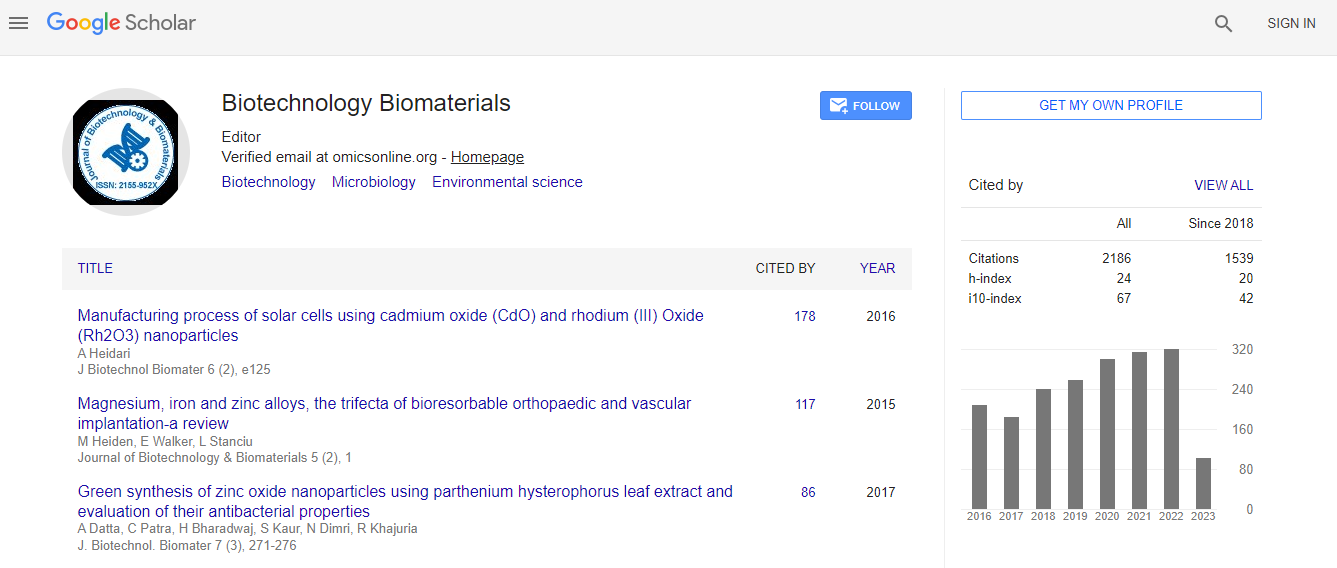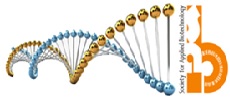Our Group organises 3000+ Global Conferenceseries Events every year across USA, Europe & Asia with support from 1000 more scientific Societies and Publishes 700+ Open Access Journals which contains over 50000 eminent personalities, reputed scientists as editorial board members.
Open Access Journals gaining more Readers and Citations
700 Journals and 15,000,000 Readers Each Journal is getting 25,000+ Readers
Google Scholar citation report
Citations : 3330
Journal of Biotechnology & Biomaterials received 3330 citations as per Google Scholar report
Indexed In
- Index Copernicus
- Google Scholar
- Sherpa Romeo
- Open J Gate
- Genamics JournalSeek
- Academic Keys
- ResearchBible
- China National Knowledge Infrastructure (CNKI)
- Access to Global Online Research in Agriculture (AGORA)
- Electronic Journals Library
- RefSeek
- Hamdard University
- EBSCO A-Z
- OCLC- WorldCat
- SWB online catalog
- Virtual Library of Biology (vifabio)
- Publons
- Geneva Foundation for Medical Education and Research
- Euro Pub
- ICMJE
Useful Links
Recommended Journals
Related Subjects
Share This Page
KrioBlast-3 - a three module system for efficient cryopreservation of unfreezable cells
21st European Biotechnology Congress
Igor l Katkov
Celltronix, USABelgorod National State Research University, Russian Federation
Keynote: J Biotechnol Biomater
Abstract
As we have stated before, there are 5 basics ways of achieving long-term storage, which ALL essentially lead to vitrification of cells, namely: slow freezing (SF), equilibrium vitrification (E-VF), kinetic vitrification (K-VF), freeze-drying (lyophilization), and va San Diego vacuum/air flow drying at temperatures above 0oC (xeropreservation). Previously, we presented KrioBlast-2, a pilot version of the KrioBlast™ platform for cryopreservation by kinetic (very fast) vitrification. One of the major advantages of K-VF over the existing approach for vitrification (E-VF) is that K-VF does not need the high concentrations of potentially toxic and intracellular vitrificants (also called: cryoprotectants, which is not exactly correct in this case) such as DMSO, ethylene glycol, dimethyl sulfamide. The pilot experiments on human pluripotent stem cells and spermatozoa, which showed an equally excellent (80-90% of the untreated control), were presented. The other key advantage of K-VF is its universality so the system is equally suitable for any kind of cells and tissues as soon as the characteristic thermal time of the system, which basically depends on the geometry of the cryo container with the sample, is sufficiently short. In this presentation, we will present the future development, the industrial three module system KrioBlast-3 that comprises 1) the cooling chamber for hyperfast cooling, 2) the intermediate module for shipment or long term storage in liquid nitrogen, and 3) the rewarming module. The second module has two port sites for the cooling and the rewarming modules so the system resembles a space station. All operations of cooling, storage/shipment, and warming are done without any contact of the sample with the ambient environment. The specific cryo containers for K-VF, namely VitriPlateTM, VitriCombTM, and VitriScanTM for vitrification of cells in suspension, packed in straws, and attached to surface in multiwell systems respectively are also discussed. Recent Publications 1. Merino O, Sanchez R, Risopatron J, Isachenko E, Katkov II, et al. (2011) Cryoprotectant-free vitrification of fish (Oncorhynchus mykiss) spermatozoa: first report. Andrologia DOI: 10.1111/j.1439-0272.2011.01196.x. 2. Katkov II, Bolyukh A F, Chernetsov O A, Dudin P I et al. (2012) Kinetic Vitrification of Spermatozoa of Vertebrates: What Can We Learn from Nature? In: Current Frontiers in Cryobiology, Eds: I I Katkov. DOI: 10.5772/34784. 3. Katkov II (2014) Stopping biological clocks: The science and art of biopreservation. BioProcess International 12(4):42- 52.Biography
Igor L Katkov is a trained biophysicist with 30+ years of experience in cryobiology and cryogenic engineering. His last years of research have been focused on the fundamental aspects of kinetic vitrification (K-VF) as well on designing the practical system for K-VF KrioBlast™ (in cooperation with V F Bolyukh). Currently, the Head of the Laboratory of the Amorphous state at the Belgorod National Research University BelSU, Russia. He has recently accepted a Professor level position as the Head of the Laboratory of Cryobiology at the V I Kulakov Research Center of Obstetrics, Gynecology and Perinatology (RCGOP), Moscow, Russia and Chief Scientific Officer of Celltronix, San Diego, CA, USA.
E-mail: prodvincell@hotmail.com

 Spanish
Spanish  Chinese
Chinese  Russian
Russian  German
German  French
French  Japanese
Japanese  Portuguese
Portuguese  Hindi
Hindi 
